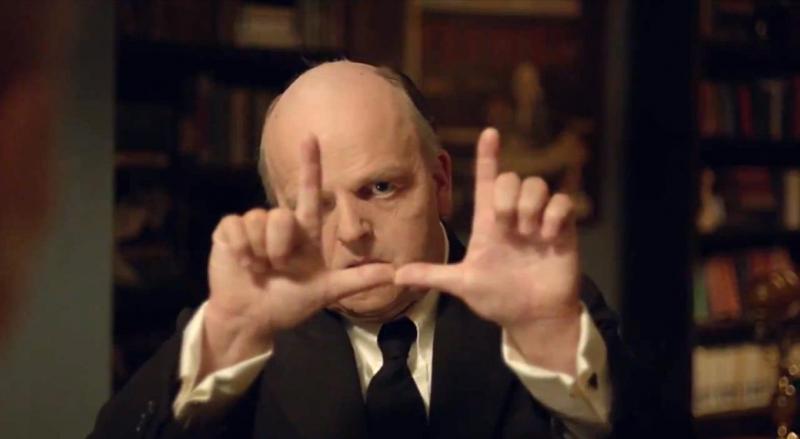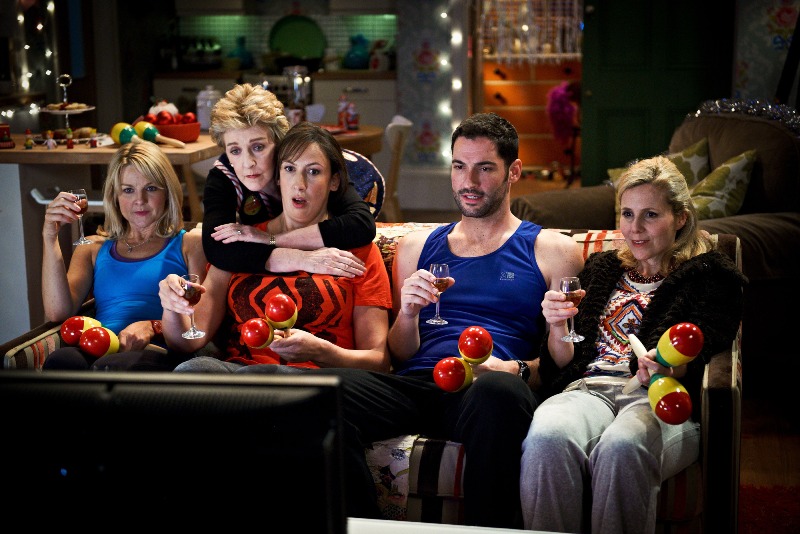The Girl, BBC Two / Miranda, BBC One | reviews, news & interviews
The Girl, BBC Two / Miranda, BBC One
The Girl, BBC Two / Miranda, BBC One
Biopic quests for the source of Hitchcock's blonde obsession. Plus a comedy brunette

The BBC makes a habit of dramatising the difficult lives of those who have entertained us – tortured comedians, anguished singers, even troubled cooks. Whatever you make of their merits, the message accumulating across all these biodramas is that the audience’s pleasure comes at the cost of the artist’s pain. Or as Alfred Hitchcock put it in The Girl, “Who pays our wages? The audience.”
And so to the master. In The Girl Hitchcock became the story rather than the storyteller, not for the first time or the last (the film starring Anthony Hopkins as Hitch is coming soon). Based on the testimony of witnesses, the script's fanciful premise was that, while shooting the last two of his films commonly accepted as classics, Hitchcock was living out his own version of the Pygmalion myth: in which the master craftsman falls in love with his stony, unrequiting creation.
Denied a way past his muse’s steely defences, the director took his pitiless revenge
The actress in question was a kind of Platonic ideal of the Hitchcock blonde. Ingrid Bergman and Kim Novak had moved on, and Grace Kelly being a Serene Highness was no longer available, so in 1960 Hitch was looking for a replacement muse. He alighted on Tippi Hedren, a model and single mother who was, in every respect, perfect: blonde and beautiful, she was also sufficiently in need of a break to surrender to Hitchcock’s vision. “I’ll be putty in your hands,” she said here, little realising that the boss’s hands would soon be wandering out of bounds.
Denied a way past his appalled muse’s steely defences, the director took his revenge: in The Birds, he sat and impassively watched as Hedren was attacked by beaks and claws for five days; then in Marnie, he scripted into her role the nudity he could bring about in no other way. His final act of malice was to refuse to release her from her seven-year contract. Why was this blonde, rather than any of the others, subjected to such callous treatment? "There's only so much I can teach you by being kind," he rationalised as he squired this white-clad vision to the premiere of The Birds like a husband brandishing a trophy bride. According to words put into the mouth of his wife Alma, the director was driven to ever greater extremes because “she makes him feel nothing he can do can break her”.
 Bringing Hitchcock’s obsessive cruelty and pitiful self-loathing to life from under several layers of prosthetics, a magnicent Toby Jones was all lizard eyes and hypnotic patter. Sienna Miller, perhaps channelling feelings provoked by voyeuristic paparazzi, was a revelation as the innocent far-from-marble fawn who totters blindly into a trap. Not that The Girl was entirely about the binary consequences of a failed seduction. Like a chorus with too much personal stake in a Greek tragedy, Imelda Staunton played Alma as Hitchcock’s nonchalant pimp until she twigged that he wanted to have more fun with this blonde than with any of her predecessors.
Bringing Hitchcock’s obsessive cruelty and pitiful self-loathing to life from under several layers of prosthetics, a magnicent Toby Jones was all lizard eyes and hypnotic patter. Sienna Miller, perhaps channelling feelings provoked by voyeuristic paparazzi, was a revelation as the innocent far-from-marble fawn who totters blindly into a trap. Not that The Girl was entirely about the binary consequences of a failed seduction. Like a chorus with too much personal stake in a Greek tragedy, Imelda Staunton played Alma as Hitchcock’s nonchalant pimp until she twigged that he wanted to have more fun with this blonde than with any of her predecessors.
As Julian Jarrold’s lens prowled and swooped in the creepy Hitchcockian manner, The Girl kept itself busy with questions about the triangular contract between director, actress and audience. Blondes, Hitchcock claimed, make the best victims, and who are we to argue as onlookers in the stories of Marilyn and Diana? Unlike more shapeless biopics, it had the dramatic trajectory of a love story. If the script by Gwyneth Hughes failed finally to take wing, it was because for all its commitment to the truth, it never delved deep enough to find the malignant source of Hitchcock’s obsessive genius. Ok so he was fat and ugly, and latterly impotent. What else? “So that’s all I ever was,” said Hedren to her self-styled creator when he turned nasty after rejection. “It’s all you ever let us be,” he replied. It's a neat inversion, but it’s no rosebud.
 Miranda Hart, if you will pardon the segue, is the polar antithesis of the Hitchcock blonde. Galumphing, chaotic, foghorn-loud and of course brunette, her big bones are also funny bones. She returned with a Boxing Day special to kick off a third series. Like many an American comedy before it, the shtick is to take a daffy comedienne and fictionalise her neuroses as entertainment. Essentially postmodern slapstick, the sitcom trades in laughing at its own pratfalls, which in this episode consisted of Miranda tripping over things, getting drenched by things, getting her clothing stuck in things and, as ever, eating sweet things. Such fun? Yes, but a little of Miranda’s infantilised portrait of 30something singledom goes a surprisingly long way.
Miranda Hart, if you will pardon the segue, is the polar antithesis of the Hitchcock blonde. Galumphing, chaotic, foghorn-loud and of course brunette, her big bones are also funny bones. She returned with a Boxing Day special to kick off a third series. Like many an American comedy before it, the shtick is to take a daffy comedienne and fictionalise her neuroses as entertainment. Essentially postmodern slapstick, the sitcom trades in laughing at its own pratfalls, which in this episode consisted of Miranda tripping over things, getting drenched by things, getting her clothing stuck in things and, as ever, eating sweet things. Such fun? Yes, but a little of Miranda’s infantilised portrait of 30something singledom goes a surprisingly long way.
The future of Arts Journalism
You can stop theartsdesk.com closing!
We urgently need financing to survive. Our fundraising drive has thus far raised £49,000 but we need to reach £100,000 or we will be forced to close. Please contribute here: https://gofund.me/c3f6033d
And if you can forward this information to anyone who might assist, we’d be grateful.

Subscribe to theartsdesk.com
Thank you for continuing to read our work on theartsdesk.com. For unlimited access to every article in its entirety, including our archive of more than 15,000 pieces, we're asking for £5 per month or £40 per year. We feel it's a very good deal, and hope you do too.
To take a subscription now simply click here.
And if you're looking for that extra gift for a friend or family member, why not treat them to a theartsdesk.com gift subscription?
more TV
 Blu-ray: The Sweeney - Series One
Influential and entertaining 1970s police drama, handsomely restored
Blu-ray: The Sweeney - Series One
Influential and entertaining 1970s police drama, handsomely restored
 I Fought the Law, ITVX review - how an 800-year-old law was challenged and changed
Sheridan Smith's raw performance dominates ITV's new docudrama about injustice
I Fought the Law, ITVX review - how an 800-year-old law was challenged and changed
Sheridan Smith's raw performance dominates ITV's new docudrama about injustice
 The Paper, Sky Max review - a spinoff of the US Office worth waiting 20 years for
Perfectly judged recycling of the original's key elements, with a star turn at its heart
The Paper, Sky Max review - a spinoff of the US Office worth waiting 20 years for
Perfectly judged recycling of the original's key elements, with a star turn at its heart
 The Guest, BBC One review - be careful what you wish for
A terrific Eve Myles stars in addictive Welsh mystery
The Guest, BBC One review - be careful what you wish for
A terrific Eve Myles stars in addictive Welsh mystery
 theartsdesk Q&A: Suranne Jones on 'Hostage', power pants and politics
The star and producer talks about taking on the role of Prime Minister, wearing high heels and living in the public eye
theartsdesk Q&A: Suranne Jones on 'Hostage', power pants and politics
The star and producer talks about taking on the role of Prime Minister, wearing high heels and living in the public eye
 King & Conqueror, BBC One review - not many kicks in 1066
Turgid medieval drama leaves viewers in the dark
King & Conqueror, BBC One review - not many kicks in 1066
Turgid medieval drama leaves viewers in the dark
 Hostage, Netflix review - entente not-too-cordiale
Suranne Jones and Julie Delpy cross swords in confused political drama
Hostage, Netflix review - entente not-too-cordiale
Suranne Jones and Julie Delpy cross swords in confused political drama
 In Flight, Channel 4 review - drugs, thugs and Bulgarian gangsters
Katherine Kelly's flight attendant is battling a sea of troubles
In Flight, Channel 4 review - drugs, thugs and Bulgarian gangsters
Katherine Kelly's flight attendant is battling a sea of troubles
 Alien: Earth, Disney+ review - was this interstellar journey really necessary?
Noah Hawley's lavish sci-fi series brings Ridley Scott's monster back home
Alien: Earth, Disney+ review - was this interstellar journey really necessary?
Noah Hawley's lavish sci-fi series brings Ridley Scott's monster back home
 The Count of Monte Cristo, U&Drama review - silly telly for the silly season
Umpteenth incarnation of the Alexandre Dumas novel is no better than it should be
The Count of Monte Cristo, U&Drama review - silly telly for the silly season
Umpteenth incarnation of the Alexandre Dumas novel is no better than it should be
 The Narrow Road to the Deep North, BBC One review - love, death and hell on the Burma railway
Richard Flanagan's prize-winning novel becomes a gruelling TV series
The Narrow Road to the Deep North, BBC One review - love, death and hell on the Burma railway
Richard Flanagan's prize-winning novel becomes a gruelling TV series
 The Waterfront, Netflix review - fish, drugs and rock'n'roll
Kevin Williamson's Carolinas crime saga makes addictive viewing
The Waterfront, Netflix review - fish, drugs and rock'n'roll
Kevin Williamson's Carolinas crime saga makes addictive viewing

Add comment